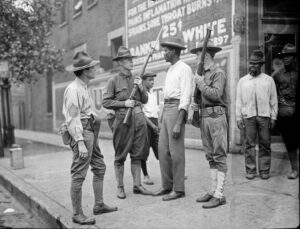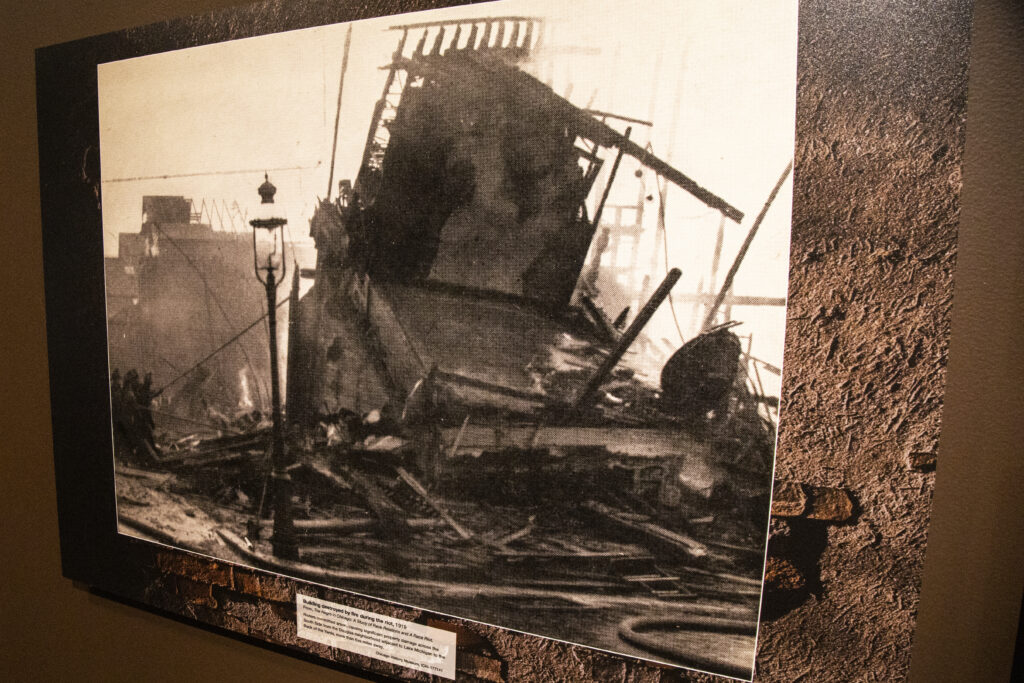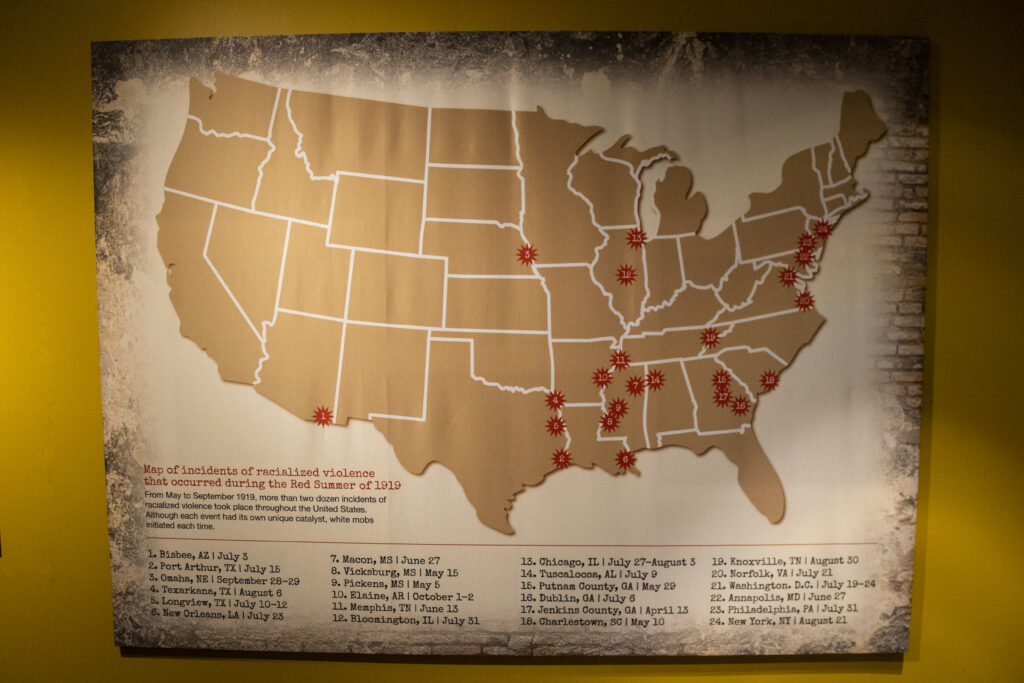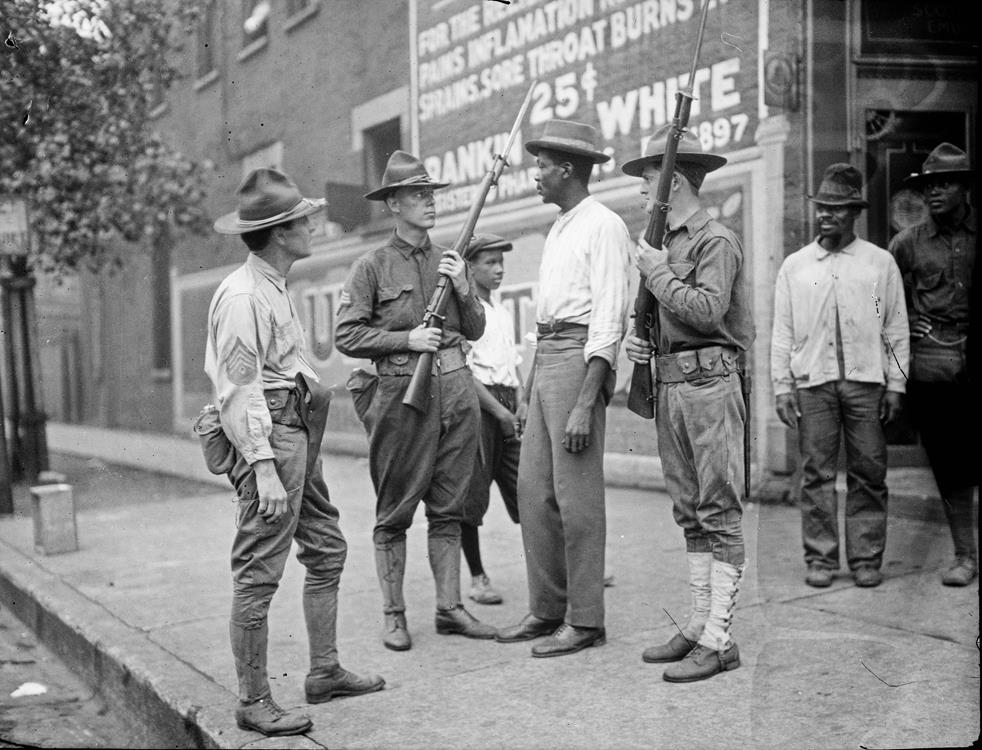Social share
Exhibition
Troubled Waters:
Chicago 1919 Race Riot
Troubled Waters: Chicago 1919 Race Riot focuses on the historical moment that led to the murder of Eugene Williams on July 27, 1919 and the eight-day aftermath that altered the city forever. The 1919 Race Riot in Chicago did not occur in a vacuum. Racial tension had been simmering in the city for years as a result of the influx of African Americans into the city as a result of the Great Migration, and global factors made officials suspicious of subversive activity.

National Guardsmen surround man on street, 1919 Photograph by Jun Fujita Chicago History Museum,
ICHi-065478
The history of Chicago, and of the United States as a whole, cannot be fully told without an acknowledgement of the role of racialized violence. As the color line was steadily established throughout the country in the decades following Reconstruction, those who sought to move beyond the limitations imposed on them on account of their race often found themselves the targets of violence.
In the summer of 1919, African Americans were actively challenging the racial status-quo. Many communities began implementing strategies to improve their opportunities to achieve equality with white Americans. This was especially true in Chicago, where established African Americans and recent southern migrants worked to improve their community, sometimes in agreement and at other times in differing ways.
On July 27 of that year, the simmering tension between those challenging the racial status-quo and those committed to keeping it in place exploded over the murder of an African American child in the waters of Lake Michigan at the hands of a white man the ensuring riot and its aftermath laid bare how far away racial equality remained.
Red Summer:
The Chicago Race Riot of 1919
-Fitchburg Sentinel newspaper, July 29, 1919

Building destroyed by fire during the riot, 1919 From, The Negro in Chicago: A Study of Race Relations and A Race Riot. Rioters committed arson, causing significant property damage across the South Side from the Douglass neighborhood adjacent to Lake Michigan to the Back of the Yards, more than five miles away. – Chicago History Museum, lCHi-177141
On a hot July day in 1919, a black teenager swimming at the 29th Street Beach crossed the imaginary line that separated the “white” and “black” areas. A white man began throwing rocks, striking the youth in the head and causing him to drown. His death set off a torrent of violence and destruction that subsided only after the arrival of the state milltia. In the end, 23 black people and 15 whites were killed, while thousands more African Americans were left homeless after their houses were burned to the ground.
The riot reflected deeper racial tensions aggravated by a slow job market and the demographic changes brought by the Great Migration. Whites met the influx of African Americans into their cities with hostility, using intimidation and discrimination to block access to jobs and housing. This social tension sparked dozens of riots during what is now known as the Red Summer.
Map of Incidents of Racialized Violence that Occurred
during the Red Summer of 1919

Map of Incidents of Racialized Violence that Occurred during the Red Summer of 1919.
DuSable Black History Museum and Education Center
From May to September 1919, more than two dozen incidents of racialized violence took place throughout the United States. Although each event had its own unique catalyst, white mobs initiated violence each time.
America in the summer of 1919 ran red with blood from racial violence, and yet today, 100 years later, not many people know it even happened.
Blood flowed in small towns like Elaine, Arkansas, in medium-size places such as Annapolis, Maryland, and Syracuse, New York, and in big cities like Washington and Chicago. Hundreds of African American men, women and children were burned alive, shot, hanged or beaten to death by white mobs. Thousands saw their homes and businesses burned to the ground and were driven out, many never to return.
It was branded “Red Summer” because of the bloodshed and amounted to some of the worst white-on-black violence in U.S. history.



